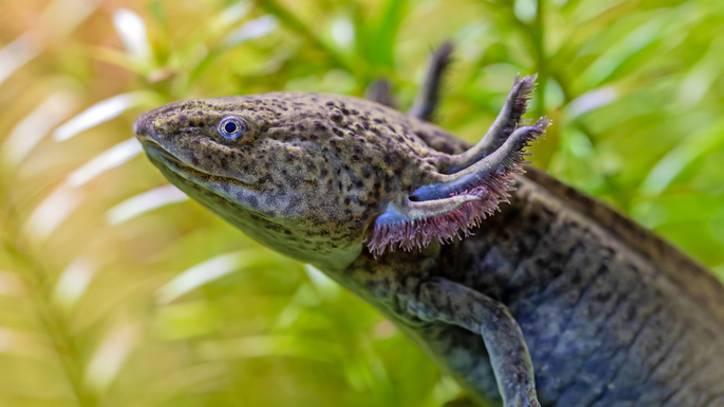What is an axolotl and do they make good pets?
Can you have an axolotl as a pet? It's important to know how to care for them properly, as well as considering legality and environmental issues

The axolotl is an unusual creature that you won’t find in the pet shop, but these Mexican amphibians can be considered unique companions.
Learn everything you need to know about this quirky salamander to be able to care for them properly, including making sure they’ve got enough space, that they’re well-fed and that their tank is cleaned regularly.
What is an axolotl?
While often mistaken for a fish, the axolotl is in fact a member of the salamander family, but, unlike other amphibians, it spends all of its life in the water.
Found only in Mexico, the axolotl gets its name from Xotlotl, the Aztec god of fire and lightning. But, while they’re a big part of Mexican culture, what makes this species special is its ability to regenerate limbs and stay “young”.
The “water monster” has a rare genetic condition called neotony, which means it maintains its larval features – its feathery gills, webbed feet and dorsal fin – into adulthood.
The quirky looking creature is a brownish grey color in the wild and a pink/white color in captivity. But what really makes them adorable pets is their upturned mouth which often makes them look as if they’re smiling.
How long do axolotls live for?
Axolotls generally live for around 10 to 15 years. However, if they are well cared for under the right conditions they can survive for up to 20 years.
Get the best advice, tips and top tech for your beloved Pets

Are axolotls considered an endangered species?
The axolotl is listed as Critically Endangered by the International Union for the Conservation of Nature (IUCN).
Found only in Lake Xochimilco and the waterways of Mexico City and with only 700-1,200 left in the wild, they are considered an endangered species. While there are now more axolotls in captivity than in the wild, these have been bred as pets with a different genetic makeup and cannot be reintroduced into their natural habitat; therefore the axolotl is still considered at risk.
The amphibian faces a number of threats including water pollution and habitat loss due to the rapid growth and development of Mexico City. Axolotls were once apex predators, but their numbers have declined since the introduction of tilapia and perch into Mexican waters.
Plus, despite the cultural significance of the axolotl, it is also a delicacy in Mexico and therefore overfishing is a threat.
Axolotl diet
Axolotls are carnivores; in the wild their diet consists of worms, insects, crustaceans, molluscs, and small fish.
Axolotl habitat
Today the axolotl can only be found in Lake Xochimilco in the Valley of Mexico and throughout the canals and waterways of Mexico City.
They once lived in Lake Chalco, but the populations here were lost when the lake was drained because of flood risks to growing developments.
Axolotls live in water at high altitudes and at temperatures of around 20 degrees Celsius (68 degrees Fahrenheit).

How big do axolotls get?
These amphibians are bigger than other salamanders. While they can range between 7-14 inches (18-36 centimeters), they tend to grow to around 9 inches (23 centimeters).
Is it legal to have a pet axolotl?
It is illegal to have a pet axolotl in some US states including California, Maine, New Jersey, Washington DC, and Virginia. In New Mexico and Hawaii you need a permit to have an axolotl as a pet and it’s illegal to import them.
In Canada, it’s illegal in New Brunswick, British Columbia and Prince Edward Island. You also need a permit in Nova Scotia.
The reason it is illegal in certain places is that if axolotls bred as pets were released into the wild, it would be a huge environmental threat; they have been bred to be so far removed from axolotls in the wild that they would be an invasive species.
If you buy a pet axolotl it is therefore important that you buy from a reputable breeder so that axolotls are never taken from the wild to be sold as pets.
Keeping and caring for axolotl as pets
To keep an axolotl as a pet you’ll need to research how to care for them properly including what to feed them, how to house them and understanding their behavior so that you know when you need to visit the vet. You can find out more about this in detail below.
You won’t find these amphibians at a pet or reptile and amphibian store; you’ll need to do your homework and find a reputable breeder. If you want a pet you can cuddle and play with, the axolotl is not for you as they shouldn’t be handled. But if you’re willing to give them everything they need, they’re adorable pets that are easy to care for.
Understanding axolotl behavior
It’s important to recognize your axolotl’s behaviors to know when something is normal or when something is wrong:
They are smiling
Just because your axolotl is smiling, it doesn’t mean it’s happy. Your pet’s mouth may just be upturned making it look like a smile or it could be swallowing food. If they do keep their mouth open for too long there could be a problem with the water such as a lack of oxygen so get this checked.
They float
Axolotls love to float in the water and this is normal behavior, but if they are floating for more than a few minutes gently tap them with a mesh net to see if they sink. They could also be floating if they are bloated or if there’s too much ammonia in the water.
They speed around their tank
This may happen if your pet is surprised by a change in light or in the water. However, if an axolotl is too active during the day (they are nocturnal) or they are swimming up to the top of the tank for air too often something could be wrong with the condition of the water.
They lift their legs
An axolotl will lift their back legs if they are having a bowel movement or to mate. They lift their front legs as a playful gesture.
They don’t spot their food
Try holding a worm right in front of your axolotl; if you drop it in their tank they may miss it as axolotls have poor eyesight an rely on smell and movement to eat. Don’t forget to clean out leftover food too to avoid infections.
They flap their gills/shake their head
Axolotls flap their gills when they are breathing. It is natural for them to gulp for air and water, but if this behavior is excessive you may want to check the water quality. If an axolotl is stressed they will bring their gills forward instead of backwards.
Purchasing an axolotl
When buying an axolotl, make sure you get it from a reputable breeder and not just from the internet or a classified ad. Make sure you ask for a full breeding and health history.
On average these amphibians cost around 20 to 70 dollars. They can be more expensive if they are a rare color such as copper. Check to see that the animal is active and willing to take food, that it looks healthy and its skin is not flaky.
Housing an axolotl
Axolotls should be housed in a 15-20 gallon fish tank to ensure they have enough space. The fish tank will also need a secure lid so they don’t try and jump out. The fish tank should be kept out of direct sunlight at a temperature of between 14 and 20 degrees Celsius (57 and 68 degrees Fahrenheit).
Axolotls are sensitive to light so you can use an aquarium light that has a day and night cycle, but make sure it’s not too bright. If you choose to put gravel in the tank, choose a coarse variety that they will not eat. They will also love plants and hiding spots such as hollow rocks.
The water should be kept at 6.5-7 ph. If you have a filter you’ll need to change 20% of the water every week; if not every other day. If you have a filter check that It doesn’t have extreme currents as this can cause stress.

Feeding an axolotl
In captivity, an axolotl’s diet should be as close to their natural diet as possible. Pet axolotls are generally fed nightcrawlers, blackworms, daphnia, raw meat, brine shrimp, and pellets. They generally eat about two to three times a week, but it’s important to check with your vet because this will vary depending on their age and size.
Health problems in axolotls
One of the reasons axolotls need proper care and attention is that they can suffer from health problems if they do not get it.
Common health problems include bacterial infections if their tank is not cleaned regularly enough or parasitic infections if they are fed live fish and gastrointestinal problems if they consume gravel.
If the temperature rises above 24 degrees Celsius this can cause hyperthermia. They are not only sensitive to light and temperature, but if they are not handled carefully enough (a soft mesh net should be used) they can suffer from skin trauma.

